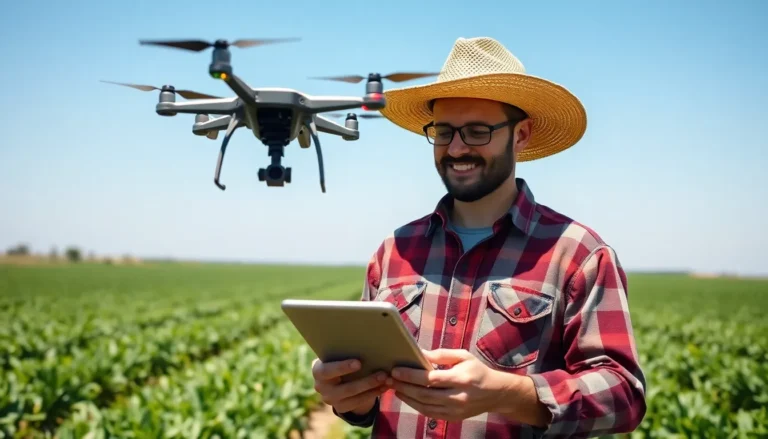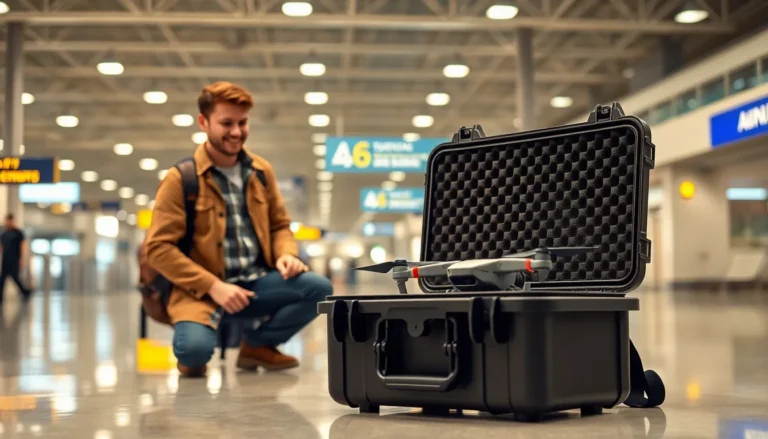Drones are buzzing around like bees in a flower garden, and it’s hard not to wonder what’s up with all the aerial activity. Whether they’re delivering packages, filming the latest viral video, or just spying on that neighbor who thinks they’re a secret agent, these flying gadgets have become a staple of modern life. But what exactly are these drones doing up there?
Table of Contents
ToggleUnderstanding Drones in Our Skies
Drones frequently populate urban areas, performing diverse functions. Their roles include package delivery, which major companies like Amazon and UPS utilize to enhance shipping efficiency. Additionally, filmmakers employ drones for capturing aerial footage, providing unique perspectives in movies and documentaries.
A growing number of individuals use drones for recreational purposes. Hobbyists operate these devices to explore landscapes, capturing stunning photographs and videos. The versatility of drones also extends to agricultural use, where farmers deploy them to monitor crops, assess health, and optimize yields.
Surveillance applications represent another significant aspect of drone usage. Some law enforcement agencies implement drones for monitoring traffic, crowd control, and emergency response. This capability helps improve public safety through rapid assessment of situations.
Regulatory frameworks govern drone operations, ensuring safety and compliance. The Federal Aviation Administration (FAA) regulates commercial drone use in the United States. Registration is mandatory for most drones over a specific weight, including guidelines for where and how drones can operate.
As technology advances, so does the functionality of drones. Autonomous flying capabilities enhance their utility, allowing for pre-programmed routes and real-time data collection. Meanwhile, emerging technologies such as artificial intelligence integrate with drones for improved decision-making.
Drones are transforming everyday life, similar to the presence of bees in a garden. Their applications span multiple industries, influencing logistics, entertainment, agriculture, and public safety. Understanding their evolving roles provides insight into how drones are reshaping various sectors in contemporary society.
Types of Drones
Drones serve a variety of purposes, categorized based on their application. Understanding these types reveals the diverse roles they play in society.
Commercial Drones
Commercial drones dominate sectors like logistics, agriculture, and media. Companies like Amazon and UPS utilize these devices for efficient package delivery, reaching areas quickly that trucks cannot. In agriculture, farmers apply drones to survey crops, gather data, and improve yields. Filmmakers exploit aerial drones to capture stunning visuals, transforming how stories are told. Regulations, issued by the Federal Aviation Administration, dictate operational protocols for these drones, ensuring they operate safely in shared airspace.
Recreational Drones
Recreational drones provide enthusiasts with a new outlet for creativity and exploration. Users fly these drones to photograph landscapes from unique perspectives or participate in drone racing for fun and competition. Many models are user-friendly, allowing individuals to begin flying with minimal experience. Communities have formed around this hobby, sharing tips and breathtaking aerial footage. Regulations still apply, ensuring drone operations remain safe and respectful of privacy.
Military Drones
Military drones play a critical role in national defense and intelligence. Equipped with surveillance technology, these drones gather real-time data without risking personnel. They support missions ranging from reconnaissance to targeted strikes with high precision. Various countries deploy advanced models that incorporate artificial intelligence for enhanced operational effectiveness. Military applications of drones continue to evolve, adapting to modern combat and surveillance challenges.
Common Uses of Drones
Drones serve various purposes across multiple industries, showcasing their versatility and efficiency.
Aerial Photography and Videography
Drones excel in capturing stunning aerial photography and videography. Filmmakers utilize them to achieve dynamic shots that were once difficult or costly to obtain. Unique perspectives from the sky enhance storytelling in movies and documentaries. Event planners benefit by using drones for aerial images of gatherings like weddings and festivals. Professional photographers capture breathtaking landscapes and wildlife. These tools democratize aerial imaging, allowing amateur enthusiasts to experiment creatively.
Delivery Services
Drones revolutionize delivery services, especially in urban environments. Companies like Amazon and UPS implement drones for swift package delivery, significantly reducing transportation time. Minor orders benefit from this efficiency, as drones navigate directly to customers’ doorsteps. Users appreciate the convenience of receiving goods in hours rather than days. Medical supplies also rely on drone deliveries, facilitating timely access to critical items in remote areas. Regulatory bodies support these innovations, fostering safe operational frameworks.
Agricultural Monitoring
Drones play a crucial role in agricultural monitoring, transforming farming practices. Farmers employ drones to survey vast fields with ease, optimizing crop management techniques. High-resolution imagery allows for precise assessments of plant health, irrigation needs, and pest control. Yield predictions become more accurate through frequent aerial data collection. Additionally, these technologies contribute to sustainable farming, minimizing waste and maximizing productivity. As farmers embrace drone technology, the future of agriculture evolves toward greater efficiency and environmental responsibility.
Safety and Regulations
Drones operate under stringent safety regulations to protect both users and the public. Various legal requirements ensure responsible drone use.
Legal Requirements
Federal Aviation Administration (FAA) regulations govern drone operations in the United States. Operators must register their drones that exceed 0.55 pounds. Certificate of Authorization (COA) mandates exist for commercial flight operations. Additionally, users must maintain visual line of sight with their drones during flight. This helps to avoid accidents and conflicts with other air traffic. Compliance with local laws is essential, as restrictions may vary by state or municipality. Operators should also consider height limits and areas where drone flight is prohibited.
Safety Precautions for Users
Safety precautions play a crucial role in minimizing risks associated with drone usage. First, pre-flight inspections check for mechanical issues and battery life. Another important step involves identifying the surroundings to avoid people, animals, and property. Users must also maintain a safe distance from airports and emergency response efforts. Following weather conditions can prevent dangerous situations while flying. Users should avoid flying at night unless equipped with appropriate lighting. Lastly, education on safe operation techniques enhances awareness, fostering responsible drone use.
Drones are rapidly becoming integral to various aspects of daily life. Their versatility spans commercial applications like logistics and agriculture to recreational uses that foster creativity and community. As technology continues to advance, the potential for drones to enhance efficiency and productivity grows.
Safety regulations play a crucial role in ensuring responsible drone operation. By adhering to these guidelines, users can enjoy the benefits of drones while minimizing risks. The future of drone technology promises even greater innovations, making it essential for society to embrace and adapt to these flying machines.





